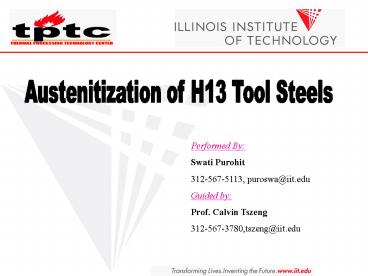Austenitization of H13 Tool Steels
1 / 18
Title:
Austenitization of H13 Tool Steels
Description:
To study the kinetics of transformation to austenite and the ... of lineal analysis to determine the volume percent of carbide remaining out of solution. ... –
Number of Views:530
Avg rating:3.0/5.0
Title: Austenitization of H13 Tool Steels
1
Austenitization of H13 Tool Steels
Performed By Swati Purohit 312-567-5113,
puroswa_at_iit.edu Guided by Prof. Calvin
Tszeng 312-567-3780,tszeng_at_iit.edu
2
- Objective
- To study the kinetics of transformation to
austenite and the kinetics of carbide dissolution
for the H13 tool steels.
3
Strategy
- Conduct a literature survey in order to identify
and analyze different process parameters and the
other process complexities. - Review those parameters used by different
authors and compare them amongst themselves in
order to find out their limitations. - Study the transformation to austenite
quantitatively by considering the effect of
various parameters, i.e. the heat-treatment
cycles and the size of the sample.
4
- Study the various types of carbides formed at
different temperature and analyze the volume
percent carbide formed as a function of
austenitizing temperature. - Study the kinetics of carbide dissolution for
different austenitizing conditions and to
understand how the variations in austenitizing
condition affect the kinetics of the carbide
dissolution.
5
- Work Plan
- Literature survey on heat-treatment
microstructure and - related properties of Hot Work Tool Steels
- Knowing various Equipment
- Design of Experiment
- Model development to study the ferrite to
austenite - transformation and the kinetics of carbide
dissolution
6
Approach
- Material and Experimental Procedure
- 1.1 Material
- 1.2 Experimental procedure
- 1.2.1 Austenitization
- 1.2.2 Quantitative Determination of Austenite
- 1.2.3 Carbide Dissolution Determination
- 1.3 Data Analysis
- 1.3.1 Austenite formation kinetics
- 1.3.2 Carbide dissolution behavior
7
- 1.1 Material
- Composition
- AISI H13 Tool Steel
- C 0.35
- Si 1.00
- Cr 5.00
- Mo 1.50
- V 1.00
8
- 1.2 Experimental Procedure
- 1.2.1 Austenitization
- Austenitization using Gleeble is carried out at
different austenitizing temperature of 18500F,
19000F, 19500F, 20000F for different holding time
of 30, 60, 90 minutes.
9
AUSTENITIZING - QUENCHING
SOAKING
QUENCHING
Temperature
HEATING
Time
Figure1 Heating Cycle
10
- 1.2.2 Quantitative Determination of Austenite
- Carried out to study the Austenite
Transformation. - Following heat-treating a longitudinal surface
from each specimen can be prepared - for metallographic examination using the
std. ASTM procedures and the - microstructure examination can be done using
the SEM and optical microscope. - Volume fraction of the austenite formed can be
carried out using the Image analysis. - For each combination of time/temperature used
two- three specimen can be - examined.
- The data are analyzed as a function of volume
transformed with respect to log time - for different austenitizing temperature.
11
- 1.2.3 Carbide dissolution determination
- The quantitative analysis of the various types
of carbides present can be carried out by the
electron diffraction pattern analysis and the EDS
analysis using the carbon extraction replicas. - Following heat treating a longitudinal surface
from each specimen can be prepared for
metallographic examination. 5 Nital can be used
as the Etchant. - The carbide solutioning behavior of these test
pieces can be measured using the technique of
lineal analysis to determine the volume percent
of carbide remaining out of solution. The total
length percent of carbide intersected by random
lines on fields at a magnification of 1000 X can
be measured and these values can be averaged to
yield the total length percent of carbide, which
can be directly related to the volume percent of
carbide present in steel. - These data are analyzed as a function of
austenitizing temperature.
12
1.3 Data Analysis
- 1.3.1 Austenite Transformation Kinetics
- The fraction of austenite volume transformed as a
function of time can be given as, - Here,
- reaction constant
- reaction exponent
- This equation can be written in the form as,
- The plot of vs.
can be obtained as, - The reaction exponent n can be determined from
the slope of the resulting graph. - The slope verywith transformation temperature.
13
n3
ln(1/(1-f))
n2
f
n1
Log t (sec)
Log t
Fig.2 Amount of austenite f vs. logarithm of time
at austenitizing temperature
Fig.3 Graph of log ln 1/ (1-f) vs. log t
14
- 1.3.2 Carbide Dissolution
- The analysis of volume percent primary carbide
with respect to temperature gives the following
expected plot.
Volume primary carbide
Temperature
Fig.5 Plot of volume primary carbide versus
austenitizing temperature
15
- Thermocalc software is used for the study of
the carbide dissolution behavior. - DICTRA interfaced with Thermocalc - a general
software package for simulation of diffusion
controlled transformation in multicomponent
alloys is used. - The diffusion simulations are based on assessed
kinetic and thermodynamic data, which have been
stored in database. - In DICTRA, the multicomponent diffusion
equation, - Is solved using a complete (n-1) x (n-1)
temperature and concentartion dependent
diffusivity matrix . The diffusivity matrix
is calculated from the parameters stored in a
mobility database and a thermodynamic database.
16
- This approach may be conveniently coupled with a
thermodynamic calculation of the local
equilibrium at a moving phase interface. - The modules of the computer program given by
Agren is as below.
Solve flux balances
Rate of reaction
Solve diffusion
Local equilibrium
Gibbs energy
Kinetics
d2G/dX2
Databanks
Thermodynamics
Kinetics
17
Future plan of work
- Continue the Literature Search
- Develop the model
- Contact Finkl Sons for samples
- Start the Experiment
18
(No Transcript)































